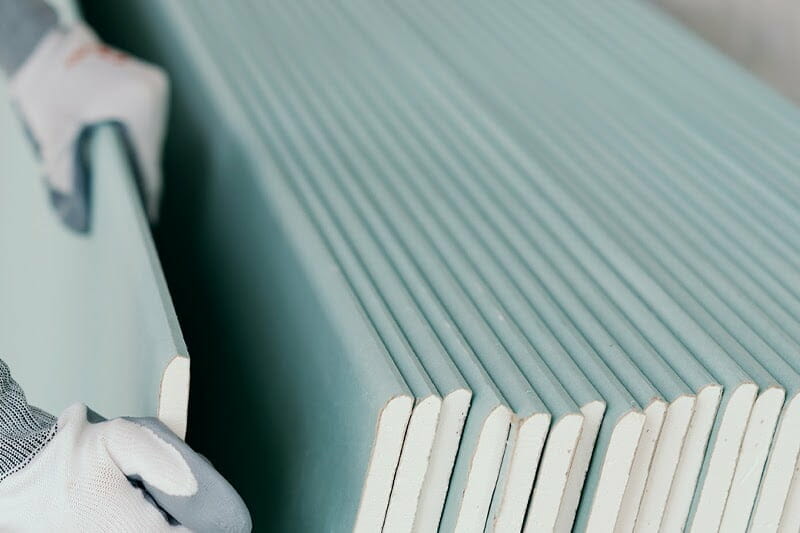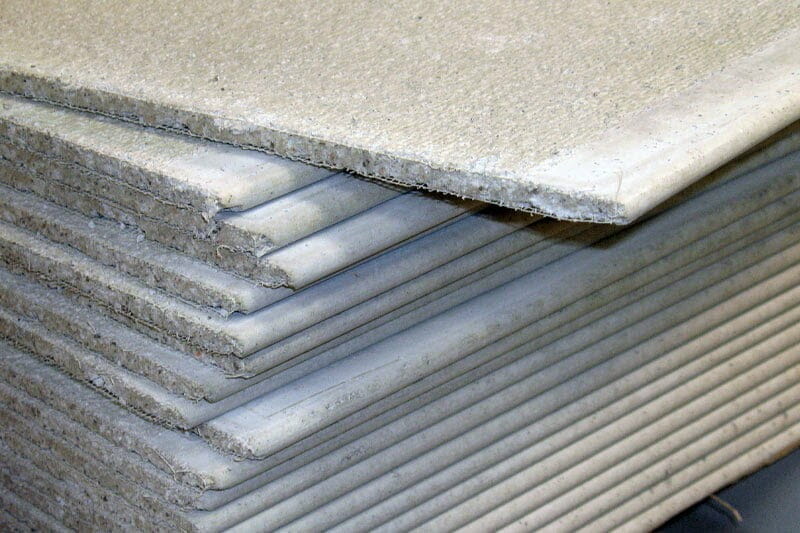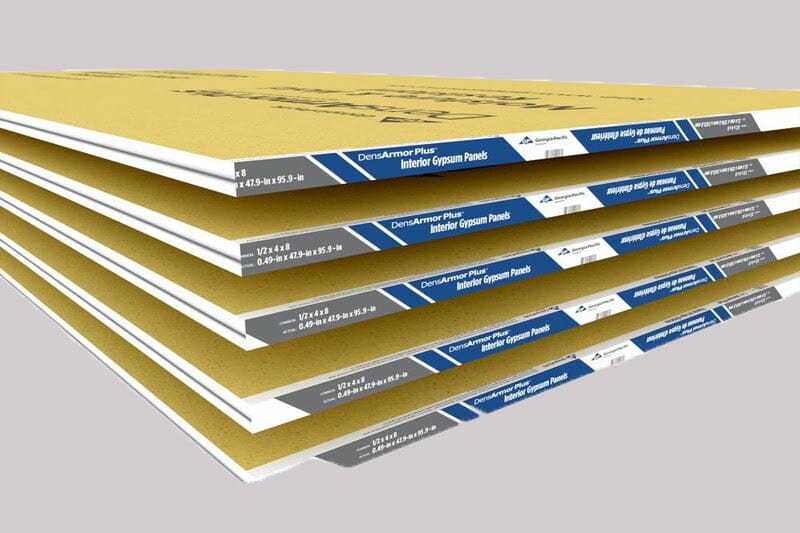Drywall and cement board serve identical purposes. These pre-made panels are perfect for improving your home’s interior.
Drywall is compressed gypsum covered with paper, while cement boards are a much harder panel formed by cement slurry and reinforced fiberglass mesh. Drywall is the best choice for residential homes while cement board is used for more commercial settings.
In this article, we will talk about the differences between these two materials, the cost, installation, fire rating, and a few more things. Stay tuned!
What we cover
ToggleCement Board vs Drywall at a Glance
| Drywall | Cement Board | |
|---|---|---|
| Cost | $0.55 per sq. ft. | $5.87 per sq. ft. |
| Thickness | 1/4" - 1/2" | 1/4" - 1” |
| Fire rating | Excellent (X type) | Excellent |
| Soundproof | Fair | Excellent |
| Use case | Residential | Commercial |
Drywall
Drywall, also known as wallboard, is a compressed gypsum panel covered with paper facing, installed directly on wall studs. This material is an alternative to the traditional lath-and-plaster method of constructing interior walls. There are moisture-resistant and mold-resistant options available for installation on bathroom walls and in rooms with high humidity levels. If you DIY, drywall obtains a smooth wall surface with minimal drywall finishing skills.

Cement Board
Same as drywall, cement board also comes in panels, and there is where their similarity ends. A cement board is a very hard panel formed by cement slurry and reinforced fiberglass mesh. Since it is a strong base you can easily install tiles and stones on it, and also resists direct moisture which makes it a top choice for installation in areas of high humidity. The cement board is suitable as an underlayment on countertops, walls, and floors.

Cost of Drywall
The constant growth of drywall products on the market makes it hard to determine a budget.
On average drywall costs, $15 for a 4 x 8-foot panel, and the typical range is from $12 to $20 each. Drywall for walls and ceilings for 200 square feet will cost you between $300 to $500 or from $0.40 to $0.65 per square foot.
Thicker forms of drywall designed to add soundproofing and fire-retardant properties to the sheets are heavier and could cost you as much as $60 per panel, depending upon the benefits according to the type of drywall.
Cost Cement Board
Sometimes prices of cement board can confuse you because it was mainly used for exterior walls, like siding for example. Cement board investment is worth it if your goal is to reduce the bills for heating and cooling or if you prefer it over drywall.
The cost of a 7/16th inch cement board varies from $115 to $172 just for materials. Basic labor for a 6 to 8 hours job runs between $457 to $742, which leads us to a total of $595 to $941 or from $4.96 to $7.84 per square foot. This rough calculation refers to a 120-square-foot room.
Fire Rating
There is no 100% fireproof building material, except bricks or stones. Cement boards and drywall are considered fireproof in a way that they can stop the fire so the occupants can evacuate and firefighters have time to react and save as much as they can.
Drywall
For drywall, we can say that is relatively fire-resistant. It’s composed of gypsum pressed between two sheets of paper. Gypsum is a soft mineral that by its nature is not flammable.
Also, water is incorporated into the drywall structure so that in the presence of fire heat energy vaporizes the water gradually.
Some drywall manufacturers add glass fibers to the gypsum and that way fire resistance is increased. The glass fiber is non-combustible and helps maintain the integrity of the drywall as it is dehydrated.
Type X Drywall
Type X drywall is famous as fire-resistant. According to ASTM (American Society for Testing and Materials 5/8 inch sheets of drywall applied in a single layer to both sides of a standard wood framing will resist fire penetration for at least one hour. Drywall may be applied in multiple layers to increase fire resistance.
Fire-resistant can’t guarantee that it for sure stops fire from spreading. The purpose of using fire-resistant drywall is to slow fire spreading from its origin, limit the damage that is done, and enough time for evacuation and reaction.

Cement Board
The cement board, specifically ¼”, is deemed non-combustible according to the test of the ASTM. This does not mean that clearances to combustible materials can be reduced by using ¼” cement boards. Clearances to combustible building materials shall be obeyed even if they are protected by non-combustible material, refer to your local building code for specific combustible clearance details.
The strength of the cement board is high and the source is wide. It used to be used as a fireproof ceiling and partition wall in the past, but its fire resistance is poor. It is easy to burst and perforate in the fire field, and its protection is lost, which limits its application.
Soundproofing
If you want to cut down on the noise coming into or going out of your living area use proven sound-dampening materials, drywall and cement board, and techniques.
Drywall
In almost every way, the modern drywall-over-studs wall is better than its timber-and-masonry and plaster-and-lath predecessors. It is fast and easy to build, lightweight, and makes the most of inexpensive materials. But when it comes to stopping sound, the modern wall is a flop.
Soundproofing walls involves ripping the existing drywall off the walls, and perhaps the ceiling, filling the walls with fiberglass insulation, attaching metal strips called “resilient channels” to the studs, and fastening new drywall to the channel.
Sound-Reducing Materials
The resilient channel acts as a spring between the drywall and studs. When sound waves strike a wall built with a resilient channel, the drywall can vibrate independently without transferring the vibration to the studs. The metal channel is available at some home centers and all drywall suppliers.
Cement Board
The cement board is denser than gypsum and normally it blocks more sound. The cement board is made from concrete, which works to reflect and absorb sound waves. Therefore, it provides a highly effective barrier for noise transmission. The cement board is also very dense which makes it an excellent insulator against airborne or impact noises. However, if you want to silence the noise in a specific area you should add soundproofing materials.
Materials for Blocking Sound
As mentioned, additional materials should be added for the better soundproof performance of the cement board.
Insulation
Fiberglass or rock wool can really help to soundproof rooms. It is packed between the studs in walls in order to fill up airspace which can transmit sound. Look for insulation designed specifically for soundproofing.
Spray Foam
Polyurethane-based insulating material provides better soundproofing than basic fiberglass insulation as it is more compact and therefore fills the airspace more tightly.
Tiling
Tile is a hard material and it can help reduce noise transmission, especially in a bathroom or kitchen. When used on the ceiling, walls, or floors with the right underlay, tile is a great soundproofing material.
Green Glue
Green glue is a product reminiscent of caulking and comes in tubes. It is used as a noise-dampening material and applied between layers to help reduce sound vibration transference.
Pros of Cement Board
- It is available in both 1/4 inch and 1/2 inch thickness;
- The cement board won’t mildew or break down if exposed to leaks;
- Makes a great substitute for the green board in areas prone to moisture.
- Not as susceptible to water damage as drywall;
- Cement board bonds with tiles better than drywall.
Cons of Cement Board
- Per square foot, the weight makes it difficult to lift, carry and install;
- 4×8 foot sheets of cement board aren’t sold so you will need more sheets to finish your project;
- It is not completely waterproof. You will need to install a moisture barrier;
- Cutting requires carbide-tipped tools and saw blades to get precise sections;
- Cement board tends to be more expensive than products like green board.
Drywall Advantages over Cement Board
- It is easier to find and comes in more thicknesses and patterns;
- Drywall is cheaper to buy and easier to install;
- Panels are lightweight so workers are less likely to be injured;
- It is ideal for emergency repairs because it is so versatile;
- You can transport more boards at the same time;
- It is relatively easy to score and cut compared to cement board;
- Drywall is easier to position, seam, and refinish.
Cement Board Advantages over Drywall
- The cement board won’t break down like drywall over time;
- It is an ideal solution for interior walls where moisture and water are likely;
- Offers an extremely strong base for tile installation;
- Won’t warp or rot like a standard drywall product;
- Chances of mold and mildew growth are almost none;
- Also works as an underlayment for floor installs;
- Some cement boards tolerate high heat;
- Provides an extra hour of fire protection.
FAQ's
A gridlike pattern is imprinted on one surface of the cement board by the manufacturers. The pattern indicates the front of the board. Also, a cement board typically has a label or manufacturer sticker on the front of the board. On the other hand, the back of the cement board is plain, has no manufacturer-defining stickers, and is void of the front featured grid. Always install a cement board with the grid facing out.
On the downside, the cement boards are heavy, somewhat difficult to cut, and can leave abrasive sandy crumbs that can damage tubs and shower bases if you’re not careful. A cement board is a good, reliable backer board that works well on both floors and walls.
A cement board is not required for all wall tiles. For instance, a tile backsplash in your kitchen can be installed over standard drywall. This is because the wall tile in your kitchen is exposed to minimal moisture compared to shower walls.
As long as your wall is smooth and flat, you can install a ceramic tile kitchen backsplash directly over drywall or plaster with no problem. Start by cleaning the wall to remove any grease, then apply thin-set adhesive, and set the tile. After the adhesive has been set, apply grout, and you are done.












